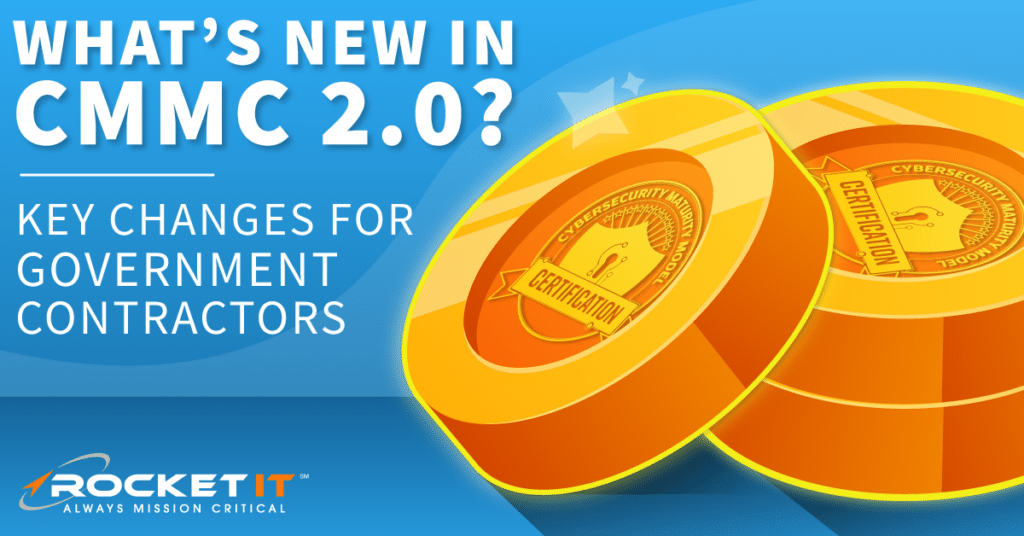What’s New in CMMC 2.0 | Key Changes for Government Contractors

Whether it be in manufacturing, law, or finance, landing a contract with a federal agency can result in massive amounts of revenue for a business. That said, when a potential contract stipulates the handling of unclassified information, it’s impossible to win without proving your organization follows proper cybersecurity practices.
Through this article, Rocket IT will walk you through the Department of Defense’s new CMMC 2.0 program to ensure your organization has the best odds of collecting federal contracts.
What Is NIST 880-171?
In the United States, there are more than 250,000 organizations that operate within the Defense Industrial Base (DIB), including contractors, subcontractors, and additional third-party groups. Understanding that this industry sector handles sensitive and unclassified information, cyber criminals have shifted their efforts to target many non-federal groups that operate under the DIB.
For organizations that have worked within the DIB in the past, it’s likely you’re familiar with the National Institute for Standards and Technology (NIST). Back in 2015, the organization launched what’s known as NIST 800-171 to help non-federal organizations secure controlled unclassified information (CUI).
Think of NIST 800-171 as a voluntary checklist. Within it, 110 policies are outlined to help non-federal organizations prove they can properly secure the CUI of federal agencies. Unfortunately, NIST is not a regulatory body, meaning that it’s incredibly easy for federal contractors and third parties to falsely state they uphold the cybersecurity standards outlined by NIST 800-171.
Why Did the DoD Create the CMMC?
Seeing that the NIST 800-171 framework was often optional and not adhered to by most organizations, the Department of Defense (DoD) created the Cybersecurity Maturity Model Certification (CMMC) program to give non-federal organizations a credible means to vouch for their cybersecurity infrastructures.
CMMC 1.0 VS CMMC 2.0
CMMC is broken down into stages, providing non-federal organizations with an opportunity to attain a certificate at each maturity level. Originally, CMMC contained five maturity levels, requiring participants to demonstrate security processes to graduate to the next stage.
As of November 2021, CMMC 2.0 condensed the level model from five to three, making it easier for contractors and third parties to attain clearance to work with federal agencies.
That said, while level 1 of CMMC 2.0 is an annual self-assessment with 17 cybersecurity policies to enforce for certification, attaining level two and three certificates requires third-party assessments to ensure standards are met.
Simply put, level 2 of CMMC 2.0 can be seen as an enforceable version NIST 800-171. Using the same 110 cybersecurity controls outlined in NIST 800-171, level 2 of CMMC 2.0 is now the standard non-federal organizations must achieve to attain contracts with federal agencies. Once the level two certificate is received, most federal agencies will request that the score be submitted through a government portal for review.
Challenges with Implementing a CMCC 2.0 Compliance Solution In-house
Meeting the Department of Defense’s cybersecurity standards isn’t easy, especially for organizations with limited IT resources. And when your team is stretched thin, tackling CMMC 2.0 preparation alone can slow things down.
That’s where Rocket IT comes in. While we don’t issue certifications, Rocket IT helps organizations build the cybersecurity foundation needed to confidently pursue CMMC 2.0 compliance, without derailing daily operations.
Have questions about what it takes to get started? Call Rocket IT at 770-441-2520 or fill out the form below to speak with a cybersecurity expert.
Related Posts
Subscribe to Rocket IT's Newsletter
Stay up to date on trending technology news and important updates.

Find out if Rocket IT is the right partner for your team
Claim a free consultation with a technology expert.












